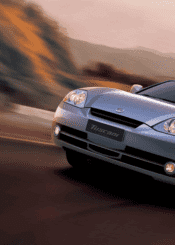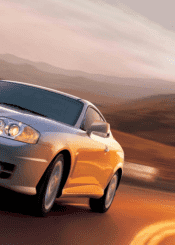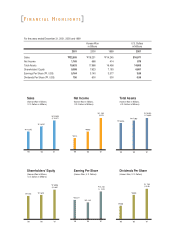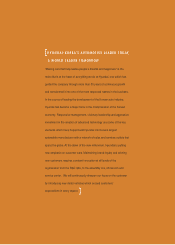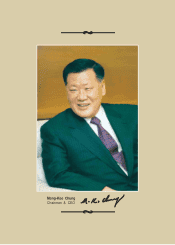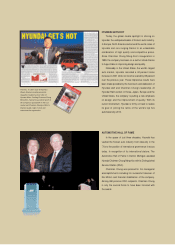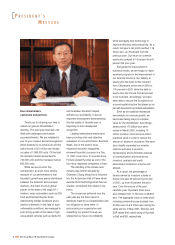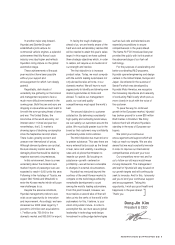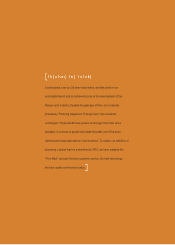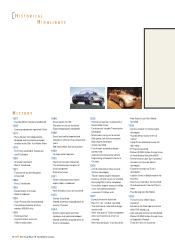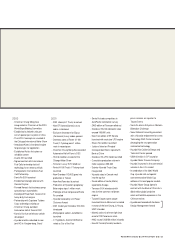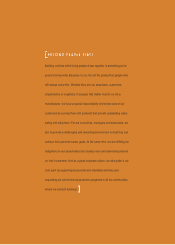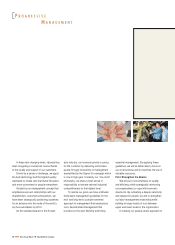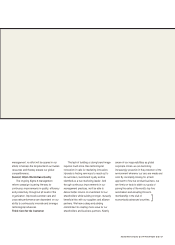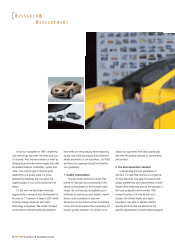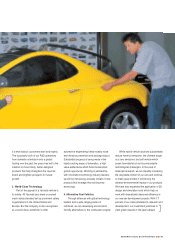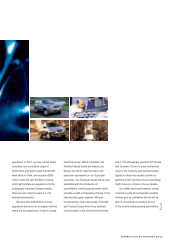Hyundai 2001 Annual Report Download - page 12
Download and view the complete annual report
Please find page 12 of the 2001 Hyundai annual report below. You can navigate through the pages in the report by either clicking on the pages listed below, or by using the keyword search tool below to find specific information within the annual report.
The ’70s: The Early Years.
By the standards of other leading
automakers around the globe, Hyundai Motor
Company’s history is quite short and may be
conveniently divided into three decades, each
of which encompasses a major era in the
company’s growth and development.
Riding the wave of the post-war building
boom, Hyundai Engineering and Construction
Co. diversified into the transportation and
machinery industry by establishing Hyundai
Motor Company in December 1967.
The young automaker turned to Ford of
the UK as its first partner to provide the
requisite technology for cars and light trucks.
This was a fruitful collaboration that led to
enduring ties between the Korean and British
auto industries. However, by the early 1970s,
Hyundai management made the critically
important decision not to rely exclusively on
foreign model licensing agreements but to
simultaneously pursue the development of its
own proprietary passenger car. With styling
input from Giorgio Giugiaro’s ItalDesign and
manufacturing know-how from Japan and the
UK, Hyundai was able to put into production
its first model, the Pony. The sub-compact
was an immediate success in the domestic
market and vaulted Hyundai into first place
where it has remained unchallenged for over
two decades. Export markets were tested
during the late 1970s and provided the
company with invaluable experience.
The ’80s: The Boom Decade.
The Korean “economic miracle” made
headlines during the 1980s as the country
expanded its industrial base and per capita
incomes rose at a double-digit annual rate.
The country was in the grip of
industrialization and was ripe for motorization.
Cars, once revered as the ultimate status
symbols in Korean society, rapidly became a
necessity of daily life. In the early 1980s, the
company made another decision, which
would prove to be critically important in later
years. Fueled by the momentum of rapid
economic growth and supported by the efforts
of the dedicated, highly educated workforce,
Hyundai invested in a major expansion of its
Ulsan plant, making a major transition from
low volume to high volume manufacturing.
Hyundai was looking beyond the national
border for future growth.
The capacity would be divided between
local market demand and serving export
markets. By the mid 1980s, Hyundai secured
a solid beachhead in Canada and was ready
to tackle the ultimate marketing challenge, the
US market.
During the late 1980s, the company
absorbed the lessons of playing in the major
leagues of North America and prepared itself
for the more intense competition that the
1990s would bring. By 1990, the company’s
cumulative exports to the US had surpassed
one million units, a milestone that put Hyundai
on the map.
The ’90s: The Pursuit of Technical
Innovation and Higher Quality.
The 1990s saw a blossoming of Hyundai’s
decade-long commitment to developing its
own technology.
In 1991, the company unveiled its first in-
house designed powerplant, the Alpha engine.
Two years later, the Beta engine was unveiled.
In January 1992, the automotive world saw
the new face of Hyundai with the unveiling of
the HCD-I concept car, establishing a tradition
of exciting concept cars that would include the
HCD-II and HCD-III. The company recorded
major progress in its development of electric
H
ISTORICAL
H
IGHLIGHTS
10
2001 Annual Report Hyundai Motor Company



